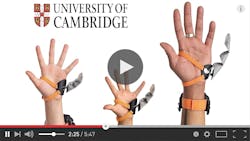Easy-to-use robotic appendage gets 3 thumbs up (literally)
Imagine for a moment that you had an extra thumb on your dominant hand. How would you use it? Would your enhanced typing talents help you write the great American novel? Would your improved instrument dexterity transform you into a better musician? Would your advanced tool-handling abilities increase productivity in the workshop or at the plant? While it might seem pointless to ask such a fanciful question, the reality of having an extra robotic limb is closer than you might think. Researchers have already engineered an easy-to-use Third Thumb which is poised to change the way we think about prosthetic devices.
The Third Thumb was created by Dani Clode. She is currently the Head Designer and Senior Technical Specialist at the Plasticity Lab, which is part of the Medical Research Council (MRC) Cognition and Brain Sciences Unit at the University of Cambridge. According to Dani, the 3D-printed thumb extension is “part tool, part experience, and part research; a catalyst and model by which we can better understand human response to artificial extensions.” The robotic thumb was engineered to improve the functionality of the wear’s hand. Tasks that were once too complex or seemingly impossible to accomplish one handed are achievable thanks to the wearer’s increased range of movement and grasping capacity.
In a recent article for the University of Cambridge, author Craig Brierley explains how the Third Thumb works. “The Third Thumb is worn on the opposite side of the palm to the biological thumb and controlled by a pressure sensor placed under each big toe or foot. Pressure from the right toe pulls the Thumb across the hand, while the pressure exerted with the left toe pulls the Thumb up toward the fingers. The extent of the Thumb’s movement is proportional to the pressure applied, and releasing pressure moves it back to its original position.”
The Third Thumb was tested by a range of individuals at the annual Royal Society Summer Science Exhibition in 2022. A total of 596 people participated in the test, with users ranging in age from three to 96 years old. The experiment lasted five days, and only four participants were unable to use the robotic device.
The team presented their results in a paper titled “Robotic hand augmentation drives changes in neural body representation,” which was published in Science Robotics. In an excerpt from the paper, the researchers write: “During daily training sessions, participants were presented with a variety of reaching, grasping, and in-hand manipulation tasks designed to introduce complex hand-robot interactions and to be purposefully challenging to perform with only one hand. In the collaboration tasks, participants had to use the Thumb together with another finger to pick up multiple objects. In the shared supervision tasks, participants had to use the Thumb to extend the natural grip of the hand and to free up the use of their biological fingers. Last, in the individuation task, participants had to work on the fine motor control of the Thumb while having their hand fully occupied with a task-irrelevant object. Augmentation participants showed significant improvement on all the training tasks.”
On a philosophical level, the Third Thumb is challenging our perception of ability and the use of prosthetics. The robotic augmentation was not engineered solely for users with missing digits. Like an exoskeleton, the Third Thumb has the potential to redefine the limits of the human body. According to Dani, “The origin of the word ‘prosthesis’ meant ’to add, put onto’; so not to fix or replace, but to extend. The project is inspired by this word origin, exploring human augmentation and aiming to reframe prosthetics as extensions of the body.”
The team also focused on diversity when designing and testing the Third Thumb. In a recent quote, Dani said, "Given the diversity of bodies, it's crucial that the design stage of wearable technology is as inclusive as possible. It's equally important that these devices are accessible and functional for a wide range of users. Additionally, they should be easy for people to learn and use quickly."
Co-author Lucy Dowdall added, "We’ll need to factor in different ages, genders, weight, lifestyles, disabilities – as well as people’s cultural, financial backgrounds, and even likes or dislikes of technology. Physical testing of large and diverse groups of individuals is essential to achieve this goal."
About the Author
Alexis Gajewski
Senior Content Strategist
Alexis Gajewski has over 15 years of experience in the maintenance, reliability, operations, and manufacturing space. She joined Plant Services in 2008 and works to bring readers the news, insight, and information they need to make the right decisions for their plants. Alexis also authors “The Lighter Side of Manufacturing,” a blog that highlights the fun and innovative advances in the industrial sector.
